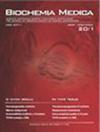临床实验室血液酒精浓度:诊断和法医检测分析前阶段的叙述性回顾
IF 1.8
3区 医学
Q1 MEDICAL LABORATORY TECHNOLOGY
引用次数: 0
摘要
血液酒精浓度(BAC)分析是一项关键的毒理学测试,涉及急性酒精中毒(AAI)和酒后驾驶(DUI)。因此,BAC对临床实验室提出了组织上的挑战,由于需要作为诊断过程的一部分的法医防御能力,BAC具有独特的复杂性。不幸的是,大量涉及该主题的科学调查存在差异,这使得很难确定样品收集,运输,处理和制备的最佳实践。这篇综述提供了对BAC分析前阶段的系统分析,旨在识别和解释可控操作因素背后的化学、生理和药理学机制。尽管如此,它寻求证据的必要性,以分离诊断和法医BAC测试的分析前过程。在这方面,本综述的主要发现是,除了整个监管链的可追溯性外,没有文献证据支持区分AAI和DUI的分析前程序的必要性。事实上,按照欧洲临床化学和检验医学联合会(European federation of clinical chemistry and laboratory medicine)等官方机构提供的正确分析前程序进行常规放血,既能保证BAC的诊断准确性,又能保证BAC的法医辩护能力。这取决于现代预抽真空无菌收集管控制影响BAC的主要因素的能力,即非酶氧化和微生物污染。虽然此类设备的某些限制已经过时,例如使用氟化钠(NaF)来特定保存法医BAC,但本综述强化了使用非酒精消毒剂作为在急诊科等具有挑战性的操作环境中实现“防错”程序的建议。本文章由计算机程序翻译,如有差异,请以英文原文为准。
Blood alcohol concentration in the clinical laboratory: a narrative review of the preanalytical phase in diagnostic and forensic testing
The analysis of blood alcohol concentration (BAC), a pivotal toxicological test, concerns acute alcohol intoxication (AAI) and driving under the influence (DUI). As such, BAC presents an organizational challenge for clinical laboratories, with unique complexities due to the need for forensic defensibility as part of the diagnostic process. Unfortunately, a significant number of scientific investigations dealing with the subject present discrepancies that make it difficult to identify optimal practices in sample collection, transportation, handling, and preparation. This review provides a systematic analysis of the preanalytical phase of BAC that aims to identify and explain the chemical, physiological, and pharmacological mechanisms underlying controllable operational factors. Nevertheless, it seeks evidence for the necessity to separate preanalytical processes for diagnostic and forensic BAC testing. In this regard, the main finding of this review is that no literature evidence supports the necessity to differentiate preanalytical procedures for AAI and DUI, except for the traceability throughout the chain of custody. In fact, adhering to correct preanalytical procedures provided by official bodies such as European federation of clinical chemistry and laboratory medicine for routine phlebotomy ensures both diagnostic accuracy and forensic defensibility of BAC. This is shown to depend on the capability of modern pre-evacuated sterile collection tubes to control major factors influencing BAC, namely non-enzymatic oxidation and microbial contamination. While certain restrictions become obsolete with such devices, as the use of sodium fluoride (NaF) for specific preservation of forensic BAC, this review reinforces the recommendation to use non-alcoholic disinfectants as a means to achieve “error-proof” procedures in challenging operational environments like the emergency department.
求助全文
通过发布文献求助,成功后即可免费获取论文全文。
去求助
来源期刊

Biochemia Medica
医学-医学实验技术
CiteScore
5.50
自引率
3.00%
发文量
70
审稿时长
>12 weeks
期刊介绍:
Biochemia Medica is the official peer-reviewed journal of the Croatian Society of Medical Biochemistry and Laboratory Medicine. Journal provides a wide coverage of research in all aspects of clinical chemistry and laboratory medicine. Following categories fit into the scope of the Journal: general clinical chemistry, haematology and haemostasis, molecular diagnostics and endocrinology. Development, validation and verification of analytical techniques and methods applicable to clinical chemistry and laboratory medicine are welcome as well as studies dealing with laboratory organization, automation and quality control. Journal publishes on a regular basis educative preanalytical case reports (Preanalytical mysteries), articles dealing with applied biostatistics (Lessons in biostatistics) and research integrity (Research integrity corner).
 求助内容:
求助内容: 应助结果提醒方式:
应助结果提醒方式:


